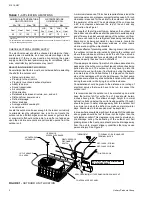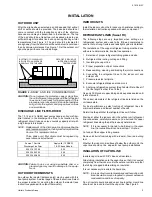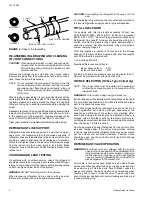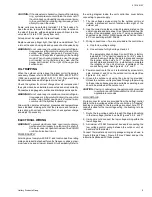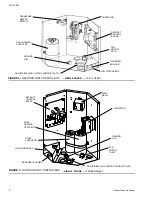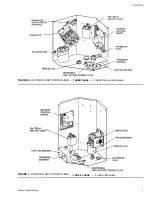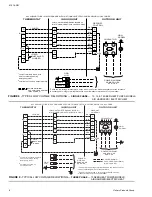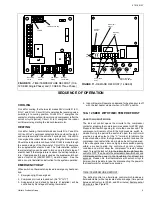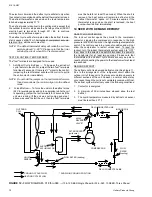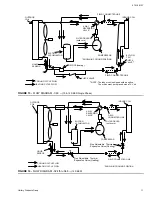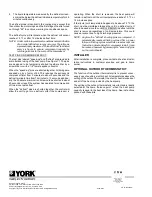
CAUTION: If the valve stem is backed out beyond the retaining
ring, system pressure could force the stem out of
the valve body and possibly cause personal injury.
In the event that the retaining ring is missing do not
attempt to open the valve.
Some units may have factory installed 1-1/8" ball valves. To
open the valve, remove the brass valve stem cap, located on
the side of the valve, with an adjustable wrench. Next, turn the
valve stem 1/4 turn CCW (away from unit).
All caps must be replaced to prevent leaks.
Replace valve cap finger tight, then tighten an additional
1
⁄
6
of
a turn with a wrench, using a back-up wrench on the valve body.
WARNING:Do not under any circumstance connect refrigera-
tion gauges or refrigerant cylinders to the vapor line
service valve (large) gauge port. Personal injury
could result if the system is operating in the heating
mode. When checking pressures use the gauge
port located on the liquid service valve and the
gauge port located to the right of the vapor line
service valve.
OIL TRAPPING
When the outdoor unit is above the indoor coil oil trapping is
necessary. Please refer to APPLICATION DATA, 690.01-AD1V
(1296) and worksheet 690.01-AD1.1V (791) "General Piping
Recommendations and Refrigerant Line Length".
Check the system for correct charge after all components of
the system have been installed, connected and wired correctly.
Connect service gauges to suction and discharge service ports.
WARNING:Do not under any circumstance connect refrigera-
tion gauges or refrigerant cylinders to the vapor line
service value (large) gauge port. Personal injury
could result if the system is operating.
Allow unit to operate until system pressures and temperatures
have stabilized, making sure that the pressure and tempera-
tures align with unit service data. If not, check system charge
and adjust if necessary.
ELECTRICAL WIRING
WARNING:To prevent electrical shock, open remote discon-
nect so electrical supply to outdoor unit is shut off.
Contactor does not open both sides of the 208/230
or 460 volt electrical circuit.
POWER SUPPLY
All wiring must comply with N.E.C. and local codes. See rating
plate and product data sheet for volts, frequency, phase, maxi-
mum fuse size and minimum branch circuit ampacity. Refer to
the wiring diagram inside the unit control box cover before
connecting to power supply.
1. The line voltage service wiring for the outdoor unit must
include a disconnect switch located within sight of the
outdoor unit.
2. Use the correct size fuse or circuit breaker as listed on the
unit rating plate and data sheet. See Tabular Data Sheet for
minimum recommended wire size. If using nonmetallic-
sheathed cable (NM or NM-B) ampacities shall be that of
60°C conductors per NEC 336-26.
3. Wiring connections. —Two are provided in the control box:
a. One for low voltage wiring.
b. One entrance for high voltage Ll and L2
The adjustable High Voltage Conduit Plate is factory
installed for 1/2" conduit connections. For 3/4" conduit,
remove the screw holding the plate in place and reverse
the location of the holes. For 1" conduit, remove the
conduit plate and discard. Re - install screw to maintain
the integrity of the unit structure, regardless of the
conduit being used. See Figures 4, 5, 6 and 7.
4. Power connection to the unit is facilitated by screw termi-
nals, marked Ll and L2 on the outdoor unit contactor. See
Figures 4, 5, 6 and 7.
5. Ground the outdoor unit using the ground lug provided.
Unless the outdoor unit is grounded through proper wiring
to the service entrance ground, a suitable separate ground
should be provided at the outdoor unit.
CAUTION: Casing or cabinet must be permanently grounded
in accordance with National Electric Code or other
applicable local codes.
LOW VOLTAGE
Pig-tail connector wires are provided from the defrost control
board to the low voltage section of the control box. A "fingered"
bushing is provided in the low voltage knockout hole. If 1/2"
conduit is used for the low voltage wiring, the bushing is to be
removed.
1. Route the low voltage cable through the fingered bushing
in the low voltage junction box. See Figures 4, 5, 6 and 7.
2. Using wire nuts, connect the low voltage wiring within the
low voltage box.
3. A minimum of 19 AWG wire must be used in connecting the
low voltage control wiring between the outdoor unit, air
handler and thermostat.
Connect thermostat and control package wiring as shown in
Figure 8 (Single Phase), Figure 9 (Three Phase) and per the
instructions packed with those pieces.
515.16-N3Y
Unitary Products Group
5


